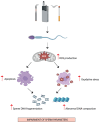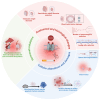The Smoky Impact of Nicotinic Acetylcholine Receptors on Testicular Function
- PMID: 39274310
- PMCID: PMC11396300
- DOI: 10.3390/jcm13175097
The Smoky Impact of Nicotinic Acetylcholine Receptors on Testicular Function
Abstract
Smoking habits (from classic cigarettes to e-cigarettes and heated tobacco) are a relatively common finding in the medical histories of couples referred to fertility centers. Tobacco smoke and e-cigarettes may deliver many substances with known harmful effects on both general and reproductive health, including nicotine. Nicotinic Acetylcholine receptors (nAChRs) form a heterogeneous family of ion channels that are differently expressed in different tissues. According to the homomeric or heteromeric combination of at least five different subunits (named from α to ε), they have peculiar pharmacological and biophysical properties. nAChRs respond to the neurotransmitter acetylcholine, which influences a number of physiological functions not restricted to neurons and plays an important role in the structure and function of non-neuronal tissues such as the testis. nAChRs are also the target of Nicotine, the active element responsible for tobacco addiction. This review summarizes recent findings on the involvement of nAChRs in testicular physiology, highlighting the effects of nicotine exposure observed in animal studies and clinical settings. We will discuss the latest data on fertility outcomes and the implications for understanding nAChR functions in reproductive health.
Keywords: Leydig cells; Sertoli cells; cigarette smoking; male fertility; nicotine; nicotinic receptors; spermatogenesis.
Conflict of interest statement
The authors declare no conflicts of interest.
Figures



Similar articles
-
Neuronal nicotinic receptors: from structure to pathology.Prog Neurobiol. 2004 Dec;74(6):363-96. doi: 10.1016/j.pneurobio.2004.09.006. Prog Neurobiol. 2004. PMID: 15649582 Review.
-
Diverse strategies targeting α7 homomeric and α6β2* heteromeric nicotinic acetylcholine receptors for smoking cessation.Ann N Y Acad Sci. 2014 Oct;1327(1):27-45. doi: 10.1111/nyas.12421. Epub 2014 Apr 14. Ann N Y Acad Sci. 2014. PMID: 24730978 Free PMC article. Review.
-
A Review on the Receptor-ligand Molecular Interactions in the Nicotinic Receptor Signaling Systems.Pak J Biol Sci. 2018;21(2):51-66. doi: 10.3923/pjbs.2018.51.66. Pak J Biol Sci. 2018. PMID: 30221881 Review.
-
The nicotinic acetylcholine receptor CHRNA5/A3/B4 gene cluster: dual role in nicotine addiction and lung cancer.Prog Neurobiol. 2010 Oct;92(2):212-26. doi: 10.1016/j.pneurobio.2010.05.003. Epub 2010 Jun 4. Prog Neurobiol. 2010. PMID: 20685379 Free PMC article. Review.
-
Insights Into Nicotinic Receptor Signaling in Nicotine Addiction: Implications for Prevention and Treatment.Curr Neuropharmacol. 2018;16(4):350-370. doi: 10.2174/1570159X15666170801103009. Curr Neuropharmacol. 2018. PMID: 28762314 Free PMC article. Review.
References
-
- World Health Organization . WHO Global Report on Trends in Prevalence of Tobacco Use 2000–2025. 4th ed. WHO Press; Geneva, Switzerland: 2021.
-
- Lang G., Henao C., Almstetter M., Arndt D., Goujon C., Maeder S. Non-Targeted Analytical Comparison of a Heated Tobacco Product Aerosol against Mainstream Cigarette Smoke: Does Heating Tobacco Produce an Inherently Different Set of Aerosol Constituents? Anal. Bioanal. Chem. 2024;416:1349–1361. doi: 10.1007/s00216-024-05126-x. - DOI - PMC - PubMed
Publication types
Grants and funding
LinkOut - more resources
Full Text Sources

